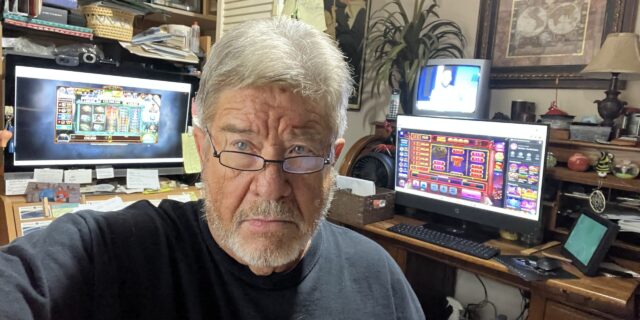
The Simmonds, was also carrying a group of 25 German Moravian missionaries, as Wesley noted in his journal: “Sunday, January 25, 1736 at seven I went to the Germans (Moravians). I had long before observed their humility by performing those servile offices for the other passengers, which none of the English would undertake saying ‘their loving Savior had done more for them’ If they were pushed, struck, or thrown down, they rose again and went away; but no complaint was found in their mouth.”
On the Wesleys’ trip to Georgia, their ship, the Simmonds, was caught in a terrible storm which shredded the main sail and flooded the deck.

John Wesley saw how everyone panicked in fear except for the Moravians, who continued to sing praise songs. He noticed their relationship with the Lord was closer than his, as he wrote in his journal: “There was now an opportunity of trying whether they were delivered from the spirit of fear. In the midst of the psalm wherewith their service began, the sea broke over, split the main-sail in pieces, covered the ship, and poured in between the decks, as if the great deep had already swallowed us up. A terrible screaming began among the English.

The Germans (Moravians) calmly sung on. I asked one of them afterwards, ‘Was you not afraid?’ He answered, ‘I thank God, no.’ I asked, ‘But were not your women and children afraid?’ He replied, mildly, ‘No; our women and children are not afraid to die.’ From them I went to their crying, trembling neighbors, and pointed out to them the difference in the hour of trial, between him that feareth God, and him that feareth him not. At twelve the wind fell. This was the most glorious day which I have hitherto seen.”
John Wesley was unsuccessful in his ministry in Georgia, and after a year, the he sailed back to England. Depressed at his failure, he accepted an invitation to attend a Moravian prayer meeting in Aldersgate in May of 1738. John was touched by the Holy Spirit and had a profound conversion experience, writing that his “heart strangely warmed.” He wrote in his journal after the prayer service: “I felt I did trust in Christ, Christ alone, for salvation; and an assurance was given me that He had taken away my sins, even mine, and saved me from the law of sin and death.”
Later in 1738, John Wesley traveled to Moravia in eastern Germany where he lived and worshiped for several months with Count Ludwig von Zinzendorf and the Moravian believers, experiencing first hand their sincere Christianity, being “the religion of the heart.” Wesley wrote in his journal: “God has given me, at length, the desire of my heart. I am with a church in whom is the mind of Christ, and who so walk as He walked.
John Wesley left Germany and returned to England, where he and his brother, Charles, began a revival movement within the Anglican Church called Methodism.

John preached thousands of sermons and organized a system of itinerate preachers who traveled through shires and towns in England in a circuit, or a circle of towns. John Wesley spoke of the inner witness of the presence of the Holy Spirit in one’s heart, as: “An inward impression on the soul of believers, whereby the Spirit of God directly testifies to their spirit that they are the children of God.”

Someone who was inspired by John Wesley to be an Anglican Methodist lay minister was 18-year-old Francis Asbury, born August 20, 1745.
(So, all the story about John Wesley is really just background; for the one that I really want you to know about is…..Francis Asbury.)
At the age 22, Francis Asbury was appointed by John Wesley to be a traveling preacher across England.

In 1771 most all of the preachers in America had died or were killed by the Indians. There was a great need for someone to go there and preach the gospel to the settlers Francis Asbury, at the age of 26, volunteered.
In 1771, Francis Asbury arrived in America, and for the next 45 years, he rode 300,000 miles on horseback, from the Atlantic to the Appalachians, from Maine to the Gulf of Mexico, spreading the Gospel. He became one of the primary forces and influences on the founding of America, though few today have ever heard of him.

In English colonies, everyone paid taxes to the King’s government, and the government paid the salaries of the Anglican pastors. Pastors lived on church-government owned farms called “glebes.”
On July 9, 1776, patriots in New York pulled down the statue of King George.

Several American colonies made it an act of treason for pastors to continued saying public prayers for the King. As the Revolution progressed, Anglican ministers faced a crisis of conscience. They had to choose between allegiance to the King and state, or allegiance to the patriotic American cause. The problem was, if they joined with those fighting for independence, they would lose their means of livelihood. As a result, most Anglican ministers returned to England, but Francis Asbury was one of the few who chose to stay in America.
Asbury stated: “I can by no means agree to leave such a field for gathering souls to Christ as we have in America.” Francis Asbury preached over 16,000 sermons in churches, town squares and court houses, addressing everyone he met, from travelers to workers in the fields to laborers in tobacco houses. He rode an average of 6,000 miles a year.

Episcopal ministers, Rev. William Smith of Maryland and Rev. William White of Philadelphia, in 1786, proposed a revised Book of Common Prayer where references to the King were replaced with references to Congress. Near that same time, at the Baltimore Christmas Conference in 1784, Francis Asbury moved the Methodist revival movement into its own denomination – the Methodist Episcopal Church.

Francis Asbury
Besides the Methodist Episcopal church the colonies had Presbyterians, Congregationalists, Puritans, Separatists, Pilgrims, Quakers, and Baptists.
Why so many churches? Answering that question is Robert D. Woodberry, assistant professor of sociology at the University of Texas–Austin who stated: “When Luther in 1521 defied an imperial order to recant by insisting that ‘my conscience is captive to the Word of God,’ he stopped being the reformer of an old order and instead became the founder of a new stream of Christianity. He could flout the commands of popes, church councils, and emperors, but not those of his own individual conscience.”
Woodberry continued: “Most Protestants follow his lead. They tend to believe that people can acquire saving faith only as they personally and individually appropriate God’s Word. They tend toward separation and independence from ancient church structures and traditions as well as political authorities. The main reason for this is the important role of individual conscience. Because saving faith must be uncoerced and individual, i
So, how did diversity of churches lay the foundation for American independence? Woodberry at U.T. Austin explained: “’The authority of Christ,’ wrote the Scots Calvinist divine William Graham in 1768, ‘removes all civil distinctions. All are upon a level equally, as they shall soon be before the awful tribunal of the great Judge.’ This stirring fusion of theology, eschatology, and politics not only characterizes Scottish Calvinism but also says much about the relationship between Protestantism and democracy.”
Rather than view the many denominations negatively, it was instead viewed positively, that they would be a check on each other to insure no one would be established as the official state denomination.
Charles Carroll, the only Catholic to sign the Declaration, wrote to Rev. John Stanford, October, 9, 1827: “Observing the Christian religion divided into many sects, I founded the hope that no one would be so predominant as to become the religion of the state. That hope was thus early entertained because all of them joined in the same cause.”

So, Rev. Francis Asbury stated: “We should so work as if we were to be saved by our works; and so rely on Jesus Christ, as if we did no works. My soul is more at rest from the tempter when I am busily employed.”
Francis Asbury wrote: “My desire is to live more to God today than yesterday, and to be more holy this day than the last. God is gracious beyond the power of language to describe. O what pride, conforming to the world and following its fashions! Warn them, warn them for me, while you have strength and time and be faithful to your duty. Preach as if you had seen heaven and its celestial inhabitants, and had hovered over the bottomless pit, and beheld the tortures, and heard the groans of the damned.”
Francis Asbury’s leadership resulted in the Methodist Church in America growing from just 1,200 people to 214,000, with 700 ordained minsters, by the time of his death in 1816.
Shortly after being sworn in as the first President, George Washington was visited in New York on May 19, 1789, by Methodist Bishop in America, Francis Asbury. The Bishop greeted Washington
Asbury continued: “We enjoy a holy expectation that you will always prove a faithful and impartial patron of genuine, vital religion— the grand end of our creation and present probationary existence. We promise you our fervent prayers to the Throne of Grace, that GOD Almighty may endue you with all the graces and gifts of his Holy Spirit, that may enable you to fill up your important station to His glory.”

On May 29, 1789, President Washington wrote a reply: “To the Bishop Asbury of the Methodist-Episcopal Church: I return to you my thanks for the demonstrations of affection and the expressions of joy on my late appointment. It shall still be my endeavor to contribute towards the preservation of the civil and religious liberties of the American people. I hope, by the assistance of Divine Providence, not altogether to disappoint the confidence which you have been pleased to repose in me; in acknowledgments of homage to the Great Governor of the Universe”
Washington continued: “I trust the people of every denomination will have every occasion to be convinced that I shall always strive to prove a faithful and impartial patron of genuine, vital religion. I take in the kindest part the promise you make of presenting your prayers at the Throne of Grace for me, and that I likewise implore the Divine benediction on yourselves and your religious community.”
Francis Asbury’s carriage driver and traveling assistant was “Black Harry” Hosier.

He had been at Asbury’s Christmas Conference of December 24, 1784, which began the Methodist Church. Though illiterate, Hosier listened to Francis Asbury’s sermons and memorized long passages of Scripture. “Black Harry” Hosier became one of the country’s most popular preachers, drawing crowds in Virginia, North Carolina, South Carolina, Boston, Connecticut, Philadelphia, Delaware, Baltimore and New York. Hosier rejected slavery, lifted up the common working man, and charged audiences “that they must be holy.” Hosier’s popularity gave birth to the name “Hoosier” being used to refer to persons of humble, low-born background who firmly held to fundamental Bible values, as the settlers who crossed the Ohio River to the Indiana shore.
President Calvin Coolidge unveiled an Equestrian Statue of Francis Asbury in Washington, D.C., 1924, stating: “Francis Asbury, the first American Bishop of the Methodist Episcopal Church made a tremendous contribution.”

Coolidge continued: “Our government rests upon religion. It is from that source that we derive our reverence for truth and justice, for equality and liberty, and for the rights of mankind. Unless the people believe in these principles they cannot believe in our government. Calling the people to righteousness (was) a direct preparation for self-government. It was for a continuation of this work that Francis Asbury was raised up.”

Coolidge added: “The government of a country never gets ahead of the religion of a country. There is no way by which we can substitute the authority of law for the virtue of man. Real reforms which society in these days is seeking will come as a result of our religious convictions, or they will not come at all. Peace, justice, humanity, charity—these cannot be legislated into being. They are the result of a Divine Grace .”
Coolidge continued about Francis Asbury: “Frontier mothers must have brought their children to him to receive his blessings! It is more than probable that Nancy Hanks, the mother of Lincoln, had heard him in her youth. Adams and Jefferson must have known him, and Jackson must have seen in him a flaming spirit as unconquerable as his own. He is entitled to rank as one of the builders of our nation. On the foundation of a religious civilization which he sought to build, our country has enjoyed greater blessing of liberty and prosperity than was ever before the lot of man. These cannot continue if we neglect the work which he did.”

Coolidge concluded: “We cannot depend on the government to do the work of religion. I do not see how anyone could recount the story of this early Bishop (Asbury) without feeling a renewed faith in our own country.”




